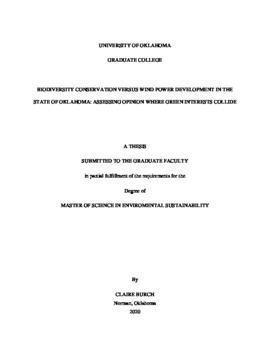| dc.contributor.advisor | Loraamm, Rebecca | |
| dc.contributor.author | Burch, Claire | |
| dc.date.accessioned | 2020-04-27T16:16:40Z | |
| dc.date.available | 2020-04-27T16:16:40Z | |
| dc.date.issued | 2020-05 | |
| dc.identifier.uri | https://hdl.handle.net/11244/324148 | |
| dc.description.abstract | Wind energy development represents one pursuit in sustainable technology meant to reduce negative impacts on the environment. Wind energy, however, may not be environmentally benign, as these activities can conflict or compete with other green interests, such as wildlife conservation. This research examines the perceptions of environmentally conscious individuals at the intersection of wind energy development and biodiversity conservation interests. The first chapter presents an extended explanation of sustainability, wind energy development, and biodiversity conservation to assist in framing my research. Chapter two presents the research conducted, titled “The ‘green on green’ conflict in wind energy development: a case study of environmentally conscious individuals in Oklahoma”. We used an online survey and distributed via environmentally related groups as well as at environmental events in the state of Oklahoma. We found that while participants were aware of the shifting causes of mortality of bird populations, they were less aware of the implications of wind energy on bat populations. In addition, attitudes towards biodiversity conservation as well as wind energy development were statistically significant when looking at how attitudes informed the identification of some impacts. Participants were also willing to support wind energy development if it had no impacts on biodiversity conservation, regardless of the trade-off presented. Attitudes towards biodiversity conservation were statistically significant in predicting almost all of these trade-offs. Lastly, various demographic factors such as gender and political affiliation were statistically significant when analyzing trade-off responses, but less demographic variables were statistically significant when analyzed in the context of the presented attitude questions. In the third chapter, I present an extended discussion of the results of my paper as well as avenues for future research using this data set. | en_US |
| dc.language | en_US | en_US |
| dc.rights | Attribution-ShareAlike 4.0 International | * |
| dc.rights.uri | https://creativecommons.org/licenses/by-sa/4.0/ | * |
| dc.subject | Energy. | en_US |
| dc.subject | Environmental Sciences. | en_US |
| dc.subject | Geography. | en_US |
| dc.title | Biodiversity conservation versus wind power development in the state of Oklahoma: assessing opinion where green interest scollide | en_US |
| dc.contributor.committeeMember | Gliedt, Travis | |
| dc.contributor.committeeMember | Peppler, Randy | |
| dc.date.manuscript | 2020-04 | |
| dc.thesis.degree | Master of Science in Environmental Sustainability | en_US |
| ou.group | College of Atmospheric and Geographic Sciences::Department of Geography and Environmental Sustainability | en_US |
| shareok.orcid | 0000-0003-0068-0440 | en_US |

